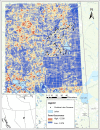Spatial structure of reproductive success infers mechanisms of ungulate invasion in Nearctic boreal landscapes
- PMID: 33520174
- PMCID: PMC7820139
- DOI: 10.1002/ece3.7103
Spatial structure of reproductive success infers mechanisms of ungulate invasion in Nearctic boreal landscapes
Abstract
Landscape change is a key driver of biodiversity declines due to habitat loss and fragmentation, but spatially shifting resources can also facilitate range expansion and invasion. Invasive populations are reproductively successful, and landscape change may buoy this success.We show how modeling the spatial structure of reproductive success can elucidate the mechanisms of range shifts and sustained invasions for mammalian species with attendant young. We use an example of white-tailed deer (deer; Odocoileus virginianus) expansion in the Nearctic boreal forest, a North American phenomenon implicated in severe declines of threatened woodland caribou (Rangifer tarandus).We hypothesized that deer reproductive success is linked to forage subsidies provided by extensive landscape change via resource extraction. We measured deer occurrence using data from 62 camera traps in northern Alberta, Canada, over three years. We weighed support for multiple competing hypotheses about deer reproductive success using multistate occupancy models and generalized linear models in an AIC-based model selection framework.Spatial patterns of reproductive success were best explained by features associated with petroleum exploration and extraction, which offer early-seral vegetation resource subsidies. Effect sizes of anthropogenic features eclipsed natural heterogeneity by two orders of magnitude. We conclude that anthropogenic early-seral forage subsidies support high springtime reproductive success, mitigating or exceeding winter losses, maintaining populations. Synthesis and Applications. Modeling spatial structuring in reproductive success can become a key goal of remote camera-based global networks, yielding ecological insights into mechanisms of invasion and range shifts to inform effective decision-making for global biodiversity conservation.
Keywords: camera trapping; fitness; invasive species; landscape change; multistate occupancy models; range shifts; reproduction.
© 2020 The Authors. Ecology and Evolution published by John Wiley & Sons Ltd.
Conflict of interest statement
The authors have no competing interests or conflict of interest to declare.
Figures




References
-
- Anderson, D. R. (2007). Model based inference in the life sciences: A primer on evidence. Springer Science & Business Media.
-
- Ballard, W. B. , Lutz, D. , Keegan, T. W. , Carpenter, L. H. , & deVos Jr, J. C. (2001). Deer‐predator relationships: A review of recent North American studies with emphasis on mule and black‐tailed deer. Wildlife Society Bulletin, 29(1), 99–115.
-
- Battin, J. (2004). When good animals love bad habitats: Ecological traps and the conservation of animal populations. Conservation Biology, 18, 1482–1491.
-
- Bayoumi, T. , & Mhleisen, M. (2006). Energy, the exchange rate, and the economy: Macroeconomic benefits of Canada's oil sands production. International Monetary Fund.
Associated data
LinkOut - more resources
Full Text Sources
Other Literature Sources

